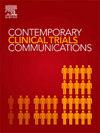Aroxybutynin and atomoxetine (AD109) for the treatment of obstructive sleep apnea: Rationale, design and baseline characteristics of the phase 3 clinical trials
IF 1.4
Q4 MEDICINE, RESEARCH & EXPERIMENTAL
引用次数: 0
Abstract
Introduction
Two key factors leading to obstructive sleep apnea (OSA) pathogenesis include relaxation of upper airway muscles at sleep onset and their insufficient reactivation during obstructive events. Medications that address this neuromuscular dysfunction by increasing upper airway tone during sleep represent a potential strategy for mitigating OSA.
Methods
AD109 is an investigational, once-daily oral agent taken at bedtime that combines an antimuscarinic, aroxybutynin (2.5 mg), with a selective norepinephrine reuptake inhibitor, atomoxetine (75 mg). LunAIRo (NCT05811247) and SynAIRgy (NCT05813275) are two ongoing, placebo-controlled 51-week and 26-week phase 3 clinical trials, respectively, investigating the efficacy and safety of AD109 to treat mild to severe OSA. Participants include adults with an apnea-hypopnea index with 4% desaturation (AHI4) >5 who either refuse or fail to tolerate positive airway pressure. Participants (LunAIRo: N = 660; SynAIRgy: N = 646) were randomized 1:1 to receive AD109 or placebo. We hypothesize that AD109 will significantly reduce AHI4 and symptomatic fatigue compared to placebo in people with OSA. The primary outcome for both trials is the change from baseline to Week 26 in AHI4 in the AD109 arm versus placebo. Key secondary outcomes include changes from baseline in oxygen desaturation index with 3% desaturation, hypoxic burden based on 4% desaturation, Patient Reported Outcome Measurement Information System (PROMIS)-Fatigue, and proportion of participants with ≥50% reduction in AHI4 at Week 26.
Discussion
LunAIRo and SynAIRgy are fully enrolled, large Phase 3 clinical trials designed to confirm and extend our understanding of the safety and efficacy of AD109, a combination oral drug targeting the underlying neuromuscular dysfunction contributing to upper airway muscle collapse during sleep in adults with OSA.
阿氧布宁和阿托西汀(AD109)治疗阻塞性睡眠呼吸暂停:3期临床试验的基本原理、设计和基线特征
导致阻塞性睡眠呼吸暂停(OSA)发病的两个关键因素包括睡眠时上呼吸道肌肉的松弛和阻塞性事件时上呼吸道肌肉的再激活不足。通过增加睡眠时上呼吸道张力来解决这种神经肌肉功能障碍的药物是缓解OSA的潜在策略。方法sad109是一种研究性药物,每日一次,睡前口服,由抗蛇毒碱阿洛布宁(2.5 mg)和选择性去甲肾上腺素再摄取抑制剂托莫西汀(75 mg)组成。LunAIRo (NCT05811247)和SynAIRgy (NCT05813275)是两项正在进行的安慰剂对照临床试验,分别为51周和26周,研究AD109治疗轻至重度OSA的有效性和安全性。参与者包括呼吸暂停低通气指数为4%去饱和(AHI4) >;5的成年人,他们拒绝或无法忍受气道正压。参与者(LunAIRo: N = 660; SynAIRgy: N = 646)以1:1的比例随机分为AD109组或安慰剂组。我们假设与安慰剂相比,AD109可以显著降低OSA患者的AHI4和症状性疲劳。两项试验的主要结局是AD109组与安慰剂组的AHI4从基线到第26周的变化。关键的次要结局包括血氧去饱和指数从基线到3%的变化,基于4%去饱和的缺氧负担,患者报告的结果测量信息系统(PROMIS)-疲劳,以及26周时AHI4降低≥50%的参与者比例。lunairo和SynAIRgy是完全入组的大型3期临床试验,旨在证实和扩展我们对AD109的安全性和有效性的理解,AD109是一种联合口服药物,针对成人OSA患者睡眠期间潜在的神经肌肉功能障碍,导致上呼吸道肌肉塌陷。
本文章由计算机程序翻译,如有差异,请以英文原文为准。
求助全文
约1分钟内获得全文
求助全文
来源期刊

Contemporary Clinical Trials Communications
Pharmacology, Toxicology and Pharmaceutics-Pharmacology
CiteScore
2.70
自引率
6.70%
发文量
146
审稿时长
20 weeks
期刊介绍:
Contemporary Clinical Trials Communications is an international peer reviewed open access journal that publishes articles pertaining to all aspects of clinical trials, including, but not limited to, design, conduct, analysis, regulation and ethics. Manuscripts submitted should appeal to a readership drawn from a wide range of disciplines including medicine, life science, pharmaceutical science, biostatistics, epidemiology, computer science, management science, behavioral science, and bioethics. Contemporary Clinical Trials Communications is unique in that it is outside the confines of disease specifications, and it strives to increase the transparency of medical research and reduce publication bias by publishing scientifically valid original research findings irrespective of their perceived importance, significance or impact. Both randomized and non-randomized trials are within the scope of the Journal. Some common topics include trial design rationale and methods, operational methodologies and challenges, and positive and negative trial results. In addition to original research, the Journal also welcomes other types of communications including, but are not limited to, methodology reviews, perspectives and discussions. Through timely dissemination of advances in clinical trials, the goal of Contemporary Clinical Trials Communications is to serve as a platform to enhance the communication and collaboration within the global clinical trials community that ultimately advances this field of research for the benefit of patients.
 求助内容:
求助内容: 应助结果提醒方式:
应助结果提醒方式:


